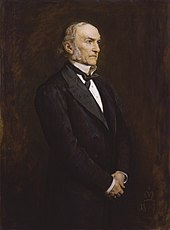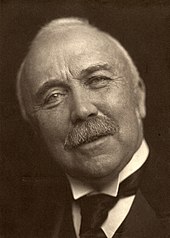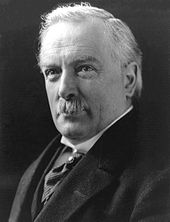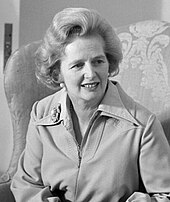Liberalism in the United Kingdom
This article has multiple issues. Please help improve it or discuss these issues on the talk page. (Learn how and when to remove these messages)
|
| Part of a series on |
| Liberalism |
|---|
 |
This article gives an overview of liberalism in the United Kingdom. It is limited to liberal parties with substantial support, mainly proved by having had a representation in parliament. The sign ⇒ denotes another party in that scheme. For inclusion in this scheme, it is not necessary that parties labelled themselves as a liberal party.
Background
In the United Kingdom, the word liberalism can have any of several meanings. Scholars use the term to refer to classical liberalism; the term also can mean economic liberalism, social liberalism or political liberalism; it can simply refer to the politics of the Liberal Democrat party; it can occasionally have the imported American meaning, including the derogatory usage by (American) conservatives. However, the derogatory connotation is much weaker in the UK than in the US, and social liberals from both the left and right wing continue to use liberal and illiberal to describe themselves and their opponents, respectively.
Historically, the term referred to the broad liberal political alliance of the nineteenth century, formed by Whigs, Peelites, and radicals. This alliance, which developed into the Liberal Party, dominated politics for much of the reign of Queen Victoria and during the years before the First World War.
British liberalism is now organised between two schools;
- the social liberalism of the Liberal Democrats (member LI, ELDR) and their counterpart the Alliance Party of Northern Ireland (member LI, ELDR),
- and the economic liberalism of the Conservative Party which was adopted in the late 1970s by the late former Prime Minister Margaret Thatcher whose fundamental changes to party policy aligned it to classical liberalism with its commitment to low taxation and economic deregulation. In his speech to the party conference in 2006, David Cameron described the party as a "liberal conservative" party, and in a speech in Bath on Thursday 22 March 2007, he described himself as a "liberal Conservative".[1]
1900s: New Liberalism
When the Liberals lost the 1895 general election, a political crisis shook the Liberal Party. Until that, the Liberal Party adhered to the Gladstonian liberalism, of free markets, low taxation, self-help and freedom of choice, but after the 1895 many Liberals claimed for a political reform. The reformers' leaders were Thomas Hill Green and Herbert Samuel, that in the Progressive Review of December 1896, said that the classical liberalism was "sapped and raddled", claiming for more state's powers.[2] Samuel's "New Liberalism" called for old-age pensions, labour exchanges (job-placement organizations), and workers' compensation, all prefiguring modern welfare. Many Liberals, including future Prime Ministers Henry Campbell-Bannerman, Winston Churchill, H. H. Asquith and Lloyd George, sceptics of non-interventionism on economy and free market, embraced the New Liberalism. During the Liberal Governments of 1905–1916, the welfare state was introduced to provide provision for lower incomes. Later, in 1908 a pension system was created with old-age pensions for people older than age 70; an income tax was introduced and in 1911 the National Insurance Act was approved.[3]
However, the Great War of 1914 reduced the Liberal support from population, and the Liberals themselves split in two factions in 1918: Asquith's supporters and George's coupons. While Asquith became Leader of the Opposition, George forged a coalition with the Conservative leader Bonar Law, continuing to be Prime Minister. However, the Liberal internal conflict caused many reformer and radical voters to join in the Labour Party, while more conservative liberals merged to the Conservatives led by Stanley Baldwin. The 1924 general election signalled the end of the Liberal Party as government force. However, the New Liberalism continued to be the preferred ideology by the Liberal Party, until its dissolution in 1988 when formed the Liberal Democrats.
1980s: Neoliberalism
With the rise of Margaret Thatcher as Conservative Party leader in the 1975 leadership election ushered in a resurgence of the old 19th-century Gladstone laissez-faire economic liberal principles. The UK in the 1970s had seen sustained high inflation rates, which were above 20% at the time of the leadership election, high unemployment, and over the winter of 1978–79 there was a series of strikes known as the "Winter of Discontent".[4] Thatcher led her party to victory at the 1979 general election with a manifesto which concentrated on the party's philosophy rather than presenting a "shopping list" of policies.[5] This philosophy became known as Thatcherism and it focused on rejecting the post-war consensus that tolerated or encouraged nationalisation, strong labour unions, heavy regulation, high taxes, and a generous welfare state.[6] Thatcherism was based on social and economic ideas from British and American intellectuals such as Friedrich Hayek and Milton Friedman. Thatcher believed that too much socially democratic-oriented government policy was leading to a long-term decline in the British economy. As a result, her government pursued a programme of economic liberalism, adopting a free-market approach to public services based on the sale of publicly owned industries and utilities, as well as a reduction in trade union power. She held the belief that the existing trend of unions was bringing economic progress to a standstill by enforcing "wildcat" strikes, keeping wages artificially high and forcing unprofitable industries to stay open.
Thatcherism promoted low inflation, the small state, and free markets through tight control of the money supply, privatisation and constraints on the labour movement. It is a key part of the worldwide economic liberal movement and as such is often compared with Reaganomics in the United States, Economic Rationalism in Australia and Rogernomics in New Zealand. Thatcherism is also often compared to classical liberalism. Milton Friedman said that "Margaret Thatcher is not in terms of belief a Tory. She is a nineteenth-century Liberal."[7] Thatcher herself stated in 1983: "I would not mind betting that if Mr Gladstone were alive today he would apply to join the Conservative Party".[8] In the 1996 Keith Joseph memorial lecture Thatcher argued that "The kind of Conservatism which he and I ... favoured would be best described as 'liberal', in the old-fashioned sense. And I mean the liberalism of Mr Gladstone, not of the latter day collectivists".[9]
Timeline of Liberal parties in Great Britain
This list (which may have dates, numbers, etc.) may be better in a sortable table format. (June 2018) |
From 1859 to 1899

- 1859
- The Whigs merged with the Peelites and Radicals into the Liberal Party. The Liberal Party win an overall majority in the 1859 general election, winning 356 seats. Henry John Temple, 3rd Viscount Palmerston becomes Prime Minister for the second time.
- 1865
- The Liberal Party win an overall majority in the 1865 general election, winning 369 seats. Lord Palmerston dies in office and is succeeded by John Russell, 1st Earl Russell.

- 1868
- The Liberal Party win an overall majority in the 1868 general election, winning 387 seats. William Ewart Gladstone becomes Prime Minister.
- 1874
- The Liberal Party lose the 1874 general election, winning 242 seats. A Conservative Government is formed.
- 1880
- The Liberal Party win an overall majority in the 1880 general election, winning 352 seats. Gladstone becomes Prime Minister for the second time.
- 1885
- The Liberal Party gain the most seats (319 seats) in the 1880 general election but fail to win an overall majority with the Irish Nationalists holding the balance of power.
- 1886
- Opponents of Irish Home Rule in the Liberal Party, led by Lord Hartington and Joseph Chamberlain, secede to form the Liberal Unionist Party. The Liberal Party lose the 1886 general election winning 191 seats. The Liberal Unionists win 77 seats and informally co-operate with the newly formed Conservative Government.
- 1892
- The Liberal Party win 272 seats in the 1892 general election and Gladstone becomes Prime Minister for the fourth time forming a minority government dependent on Irish Nationalist support. The Liberal Unionists win 45 seats.
- 1894
- Gladstone resigns as Prime Minister and his successor is Archibald Primrose, 5th Earl of Rosebery.
- 1895
- The Liberal Party lose the 1895 general election, winning 177 seats. The Liberal Unionists win 71 seats and with the Conservatives form an Unionist Government.
1900 to 1944

- 1900
- The Liberal Party win 184 seats in the 1900 general election. The Liberal Unionists win 68 seats and with the Conservatives form an Unionist Government.
- 1906
- The Liberal Party win an overall majority in the 1906 general election, winning 396 seats. Henry Campbell-Bannerman becomes Prime Minister. This would prove to be the greatest victory for the Liberals and also the last time the Liberal Party won a majority in their own right. The Liberal Unionists win 25 seats.

- 1908
- Henry Campbell-Bannerman resigns as Prime Minister and is succeeded by H. H. Asquith.
- 1910
- The Liberal Party win 274 seats and the Liberal Unionists win 32 seats in January 1910 general election. Asquith forms a government with the support of the Irish Nationalists. Another election is held in December, with the Liberal Party winning 272 seats and the Liberal Unionists winning 36 seats. This would prove the last time the Liberal Party won the highest number of seats in the House of Commons.
- 1912
- The Liberal Unionists merge with the Conservatives to form the present-day Conservative and Unionist Party (known as the Conservative Party).
- 1915
- After several British set backs in the First World War, H. H. Asquith invites the Conservatives to form a war-time coalition government. This marked the end of the last all Liberal government.

- 1916
- H. H. Asquith loses support of the Conservative Party and David Lloyd George becomes Prime Minister. The Liberal Party is now split into two factions: one camp supporting Lloyd George and the other following Asquith.
- 1918
- At the end of the war, a general election was held. The Liberal Party remained split with Lloyd George's Coalition Liberals winning 127 seats and the Asquith led Liberals winning 36 seats. Lloyd George remains Prime Minister with Conservative support.
- 1922
- Lloyd George is forced to resign after loss of support from the Conservatives. In the 1922 general election, the Lloyd George led National Liberals win 53 seats, whilst the Asquith led Liberals win 62 seats.
- 1923
- The National Liberals and the Asquith Liberal factions are re-united as one in support of free trade and the Liberal Party win 158 seats in the 1923 general election. It was the last election in which the Liberals won more than 100 seats.
- 1924
- The Liberal Party are nearly wiped out and win only 40 seats in the 1924 general election.
- 1929
- The Liberal Party win 59 seats in the 1929 general election.
- 1931
- The Liberal Party agrees to join the National Government. After the National Government proposed to fight the 1931 election for a mandate of tariffs, the Liberal Party was split into three groups. A faction, led by John Simon, supported the protectionist government policy and formed the Liberal National Party. Another faction, led by Lloyd George, became the Independent Liberals. The third grouping, the 'official' Liberal Party, was led by Herbert Samuel. In the 1931 general election, the Liberal Nationals won 35 seats, the 'official' Liberals won 33 seats, the Independent Liberals won 4 seats.
- 1933
- The 'official' Liberal Party leave the National Government.
- 1935
- In the 1935 general election, the Liberal Nationals won 33 seats, the 'official' Liberals won 21 seats, the Independent Liberals won 4 seats. Lloyd George's Independent Liberals rejoined with the rest of the 'official' Liberal Party after the general election. The Liberal Nationals remain in the National Government.
- 1940
- Both the Liberal Party and the Liberal National Party join the Churchill Wartime Government.
1945 to present day
- 1945
- The Liberal Party win 12 seats, and the Liberal Nationals win 11 seats in the 1945 general election.
- 1947
- The Liberal National Party is renamed National Liberal Party and formally merges with the Conservative Party at constituency level; however some MPs and candidates continue to use the National Liberal label (and variants thereof) for the next twenty years.
- 1950
- The Liberal Party win 9 seats in the 1950 general election. Candidates under the National Liberals banner win 17 seats.
- 1951
- The Liberal Party win 6 seats in the 1951 general election. National Liberals win 19 seats and with the Conservatives form a Conservative Government.
- 1955
- The Liberal Party win 6 seats in the 1955 general election. National Liberals win 21 seats and with the Conservatives form a Conservative Government.
- 1959
- The Liberal Party win 6 seats in the 1951 general election. National Liberals win 19 seats and with the Conservatives form a Conservative Government.
- 1964
- The Liberal Party win 9 seats in the 1964 general election. National Liberals win 6 seats.
- 1966
- The Liberal Party win 12 seats in the 1966 general election. National Liberals win 3 seats.
- 1968
- The National Liberals merge completely with the Conservative Party.
- 1970
- The Liberal Party win 6 seats in the 1970 general election.
- 1974
- The Liberal Party win 14 seats in the February 1974 general election and hold the balance of power. The Liberal Party win 13 seats in the October 1974 general election.

- 1975
- Margaret Thatcher becomes leader of the Conservative Party and the party adopts the economic liberal philosophy which became known as Thatcherism.
- 1979
- The Conservative Party win a landslide victory in the 1979 general election with 339 seats and the Liberal Party win 11 seats.
- 1981
- A faction in the Labour Party break away and form Social Democratic Party (SDP).
- 1983
- An electoral and political alliance between the Liberal Party and SDP is formed. The Liberal Party win 17 seats and the SDP win 6 seats in the 1983 general election. The Conservatives win another landslide victory with 397 seats.
- 1987
- The Conservatives win another victory with 376 seats and the Liberal–SDP alliance win 22 seats in the 1987 general election.
- 1988
- The Liberal Party merge with SDP into the Liberal Democrats. The anti-merger Liberal Party and continuing SDP are formed.
- 1992
- The Conservatives win another victory with 336 seats and new Liberal Democrats win 20 seats in the 1992 general election.
- 1997
- The Conservative win 165 seats and the Liberal Democrats win 46 seats in the 1997 general election.
- 2001
- The Conservatives win 166 seats and the Liberal Democrats win 52 seats in the 2001 general election.
- 2002
- A splinter group of the Conservative Party, the Pro-Euro Conservative Party merges into the Liberal Democrats.
- 2005
- The Conservatives win 198 seats and the Liberal Democrats win 62 seats in the 2005 general election.
- 2010
- The Conservatives win the 2010 general election with 306 seats and the Liberal Democrats win 57 seats, however with no overall control the two parties form a coalition government.
- 2015
- The Conservatives win the 2015 general election with 330 seats and the coalition is ended; the Liberal Democrats are nearly wiped out and win only 8 seats.
- 2017
- The Conservatives win another victory with 317 seats and the Liberal Democrats win 12 seats in the 2017 general election.
- 2019
- The Conservatives win the 2019 general election with 365 seats and the Liberal Democrats win 11 seats.
Timeline of Liberal parties in Northern Ireland
- 1956
- The Ulster Liberal Association is formed, and is soon renamed as the Ulster Liberal Party.
- 1969
- The Alliance Party of Northern Ireland is formed.
- 1985
- The Ulster Liberal Party fields its last candidate in a Northern Ireland election and subsequently endorses Alliance candidates instead.
- 1988
- A small branch of the Liberal Democrats is formed in Northern Ireland. Like the Ulster Liberal Party, it supports Alliance Party candidates in elections.
- 2010
- The Alliance Party of Northern Ireland win their first seat in the House of Commons of the United Kingdom at the 2010 General Election. Party leader Naomi Long becomes the MP for Belfast East.
2015
The Alliance Party of Northern Ireland lose their 1 seat in the 2015 General Election.
2019
- The Alliance Party of Northern Ireland win 1 seat in the 2019 General Election.:
Liberal leaders
| School | Party | Leaders | |
|---|---|---|---|
| Classical liberalism
style="width: 2px; color:inherit; background-color: #FF7F00;" data-sort-value="Whigs (British political party)" | |
Whig | ||
| Liberal Unionist | |||
| rowspan=2 style="background-color: Template:Liberal Party (UK)/meta/color;" | | Liberal | ||
| Social liberalism | |||
| Liberal Democrats | |||
| Alliance | |||
| Neoliberalism / Economic liberalism
style="width: 2px; color:inherit; background-color: #0087DC;" data-sort-value="Conservative Party (UK)" | |
Conservative | ||
Liberal thinkers
In the Contributions to liberal theory the following British thinkers are included:
- Thomas Hobbes (1588–1679)
- John Locke (1632–1704)
- John Trenchard (1662–1723)
- Thomas Gordon (c. 1692 – 1750)
- David Hume (1711–1776)
- Richard Price (1723–1791)
- Adam Smith (1723–1790)
- Joseph Priestley (1733–1804)
- Thomas Paine (1737–1809)
- Jeremy Bentham (1748–1832)
- James Mill (1773–1836)
- John Stuart Mill (1806–1873)
- Herbert Spencer (1820–1903)
- Thomas Hill Green (1836–1882)
- John A. Hobson (1858-1940)
- Leonard Trelawny Hobhouse (1864–1929)
- William Beveridge (1879–1963)
- John Maynard Keynes (1883–1946)
- Friedrich Hayek (1899–1992)
- Karl Raimund Popper (1902–1994)
- John Hicks (1904–1989)
- Isaiah Berlin (1909–1997)
- Ralf Dahrendorf (1929–2009)
- David Laws (born 1965)
See also
- Civil liberties in the United Kingdom
- History of the United Kingdom
- Politics of the United Kingdom
- List of political parties in the United Kingdom
- History of socialism in Great Britain
References
- ^ "British Political Speech". Retrieved 24 March 2017.
- ^ John Hoffer (2014). "New liberalism".
{{cite web}}: Unknown parameter|encyclopedia=ignored (help) - ^ Duncan Brack (2012). "The New Liberalism". Liberal Democrat History Group.
- ^ "1979: Thatcher wins Tory landslide". BBC News. 5 April 2005. Retrieved 1 April 2010.
- ^ David Butler and Dennis Kavanagh, "The British General Election of 1979", Macmillan, 1979, p. 154.
- ^ David Dutton, British Politics Since 1945: The Rise, Fall and Rebirth of Consensus (2nd ed. Blackwell, 1997).
- ^ The Observer, 26 September 1982, quoted in Robert Leach, 'What is Thatcherism?', in Martin Burch and Michael Moran (eds.), British Politics: A Reader (Manchester: Manchester University Press, 1987), p. 157.
- ^ Speech to Conservative Party Conference (14 October 1983)
- ^ "Keith Joseph Memorial Lecture ("Liberty and Limited Government") - Margaret Thatcher Foundation". www.margaretthatcher.org.
Further reading
- Bentley, Michael The Climax of Liberal Politics: British Liberalism in Theory and Practice, 1868-1918 (1987).
- Brack, Duncan, Robert Ingham, and Tony Little, eds. British Liberal Leaders (Biteback Publishing, 2015).
- Cregier, Don M. "The Murder of the British Liberal Party," The History Teacher Vol. 3, No. 4 (May, 1970), pp. 27–36 online edition
- Dangerfield, George. The Strange Death of Liberal England (1935) online free
- Dutton, David. A History of the Liberal Party Since 1900 2nd ed. Palgrave Macmillan, 2013).
- Hammond, J. L. and M. R. D. Foot. Gladstone and Liberalism (1952) online
- Häusermann, Silja, Georg Picot, and Dominik Geering. "Review article: Rethinking party politics and the welfare state–recent advances in the literature." British Journal of Political Science 43#1 (2013): 221-240. online
- Hazlehurst, Cameron. "Asquith as Prime Minister, 1908–1916," The English Historical Review 85#336 (1970), pp. 502–531 in JSTOR
- Laybourn, Keith. "The rise of Labour and the decline of Liberalism: the state of the debate." History 80.259 (1995): 207-226, historiography.
- Partridge, Michael Gladstone (2002) online; 304pp
- St. John, Ian. The Historiography of Gladstone and Disraeli (Anthem Press, 2016) 402 pp excerpt
- Thompson, J. A. "The Historians and the Decline of the Liberal Party." Albion 22.1 (1990): 65-83.
- Weiler, Peter. The New Liberalism: Liberal Social Theory in Great Britain, 1889-1914 (Routledge, 2016).
